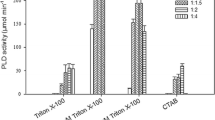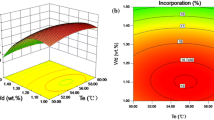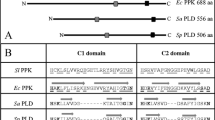Abstract
In this study, the effect of temperature on the stereoselectivity of phospholipase D (PLD) toward the two primary hydroxyl groups of glycerol in the transphosphatidylation reaction of phosphatidylcholine to phosphatidylglycerol (PtdGro) was investigated. For this purpose, PLD from bacteria (Streptomyces septatus TH-2, S. halstedii subsp. scabies K6, and Actinomadura sp.) and cabbage were tested. At the reaction temperatures employed (0–60°C), the proportions of the two PtdGro diastereomers, namely, 1,2-dioleoyl-sn-glycero-3-phospho-3′-sn-glycerol (R,R configuration) and 1,2-dioleoyl-sn-glycero-3-phosphol-1′-sn-glycerol (R,S configuration), which were produced with PLD from Streptomyces TH-2 and Actinomadura sp., changed gradually from 50% R,R and 50% R,S at 50–60°C to 70% R,R and 30% R,S at O°C. These alterations suggested that the stereoselectivity of the bacterial PLD toward the two primary hydroxyl groups of prochiral glycerol was significantly influenced by reaction temperature. PLD from Streptomyces K6 showed relatively little effect of temperature on stereoselectivity, giving 65–69% R,R in the temperature range of 60–10°C examined. The plots of In ([R,R]/[R,S]) vs. 1/T gave good linear fits for these three bacterial PLD. No temperature effect was observed for cabbage PLD, which gave an almost equimolar mixture of the R,R and R,S diastereomers in the range from 0 to 40°C. The temperature-dependent change in enantiomeric selectivity of the bacterial PLD promises potentially profitable commercial exploitation.
Similar content being viewed by others
Abbreviations
- DNPU:
-
3,5-dinitrophenylurethane
- PLD:
-
phospholipase D
- PtdCho:
-
phosphatidylcholine
- PtdGro:
-
phosphatidylglycerol
References
Heller, M. (1978) Phospholipase D, Adv. Lipid Res. 16, 267–326.
Waite, M. (1987) Plant Phospholipases, in The Phospholipases, (Hanahan, D.J., ed.) Handbook of Lipid Research 5, pp. 61–77, Plenum Press, New York.
Ulbrich-Hofmann, R. (2003) Enzyme-Catalysed Transphosphatidylation, Eur. J. Lipid Sci. Technol. 105, 305–307.
Yang, S.F., Freer, S., and Benson, A.A. (1967) Transphosphatidylation by Phospholipase D, J. Biol. Chem. 242, 477–484.
Joutti, A., and Renkonen, O. (1976) The Structure of Phosphatidyl Glycerol Prepared by Phospholipase D-Catalyzed Transphosphatidylation from Egg Lecithin and Glycerol, Chem. Phys. Lipids 17, 264–266.
Itabashi, Y., and Kuksis, A. (1997) Reassessment of Stereochemical Configuration of Natural Phosphatidylglycerols by Chiral-Phase High-Performance Liquid Chromatography and Electrospray Mass Spectrometry, Anal. Biochem. 254, 49–56.
Hagishita, T., Nishikawa, M., and Hatanaka, T. (2000) Isolation of Phospholipase D Producing Microorganisms with High Transphosphatidylation Activity, Biotech. Lett. 22, 1587–1590.
Sato, R., Itabashi, Y., Hatanaka, T., and Kuksis, A. (2004) Asymmetric in vitro Synthesis of Diastereomeric Phosphatidylglycerols from Phosphatidylcholine and Glycerol by Bacterial Phospholipase D, Lipids 39, 1013–1018.
Hatanaka, T., Negishi, T., Kubota-Akizawa, M., and Hagishita, T. (2002) Study on the Thermostability of Phospholipase D from Streptomyces sp., Biochim. Biophys. Acta 1598, 156–164.
Hatanaka, T., Negishi, T., and Mori, K. (2004) A Mutant Phospholipase D with Enhanced Thermostability from Streptomyces sp., Biochim. Biophys. Acta 1696, 75–82.
Sakai, T., Kishimoto, T., Tanaka, Y., Ema, T., and Utaka, M. (1998) Low-Temperature Method for Enhancement of Enantioselectivity in the Lipase-Catalyzed Kinetic Resolutions of Solketal and Some Chiral Alcohols, Tetrahedron Lett. 39, 7881–7884.
Sakai, T., Kawabata, I., Kishimoto, T., Ema, T., and Utaka, M. (1997) Enhancement of the Enantioselectivity in Lipase-Catalyzed Kinetic Resolutions of 3-Phenyl-2H-azirine-2-methanol by Lowering the Temperature to −40°C, J. Org. Chem. 62, 4906–4907.
Phillips, R.S. (1996) Temperature Modulation of the Stereochemistry of Enzymatic Analysis: Prospects for Exploitation, Trends Biotechnol. 14, 13–16.
Pham, V.T., and Phillips, R.S. (1990) Effects of Substrate Structure and Temperature on the Stereospecificity of Secondary Alcohol Dehydrogenase from Thermoanaerobacter ethanolicus, J. Am. Chem. Soc. 112, 3629–3632.
Sehgal, A.C., and Kelly, R.M. (2002) Enantiomeric Resolution of 2-Aryl Propionic Esters with Hyperthermophilic and Mesophilic Esterases: Contrasting Thermodynamic Mechanisms, J. Am. Chem. Soc. 124, 8190–8191.
Rich, J.O., and Khmelnitsky, Y.L. (2001) Phospholipase D-Catalyzed Transphosphatidylation in Anhydrous Organic Solvents, Biotechnol. Bioeng. 32, 374–377.
Chen, C.-S., Fujimoto, Y., Girdaukas, G., and Sih, C.J. (1982) Quantitative Analysis of Biochemical Kinetic Resolutions of Enantiomers, J. Am. Chem. Soc. 104, 7294–7299.
Leiros, I., McSweeney, S., and Hough, E. (2004) The Reaction Mechanism of Phospholipase D from Streptomyces sp. Strain PMF. Snapshots Along the Reaction Pathway Reveal a Pentacoordinate Reaction Intermediate and an Unexpected Final Product, J. Mol. Biol. 339, 805–820.
Hostetler, K.Y. (1982) Polyglycerophospholipids: Phosphatidylglycerol. Diphosphatidylglycerol and Bis(monoacylglycero)phosphate, in Phospholipids (Hawthorne, J.N., and Ansell, G.B., eds.), pp. 215–261, Elsevier Biochemical Press, Amsterdam.
Fujishima, H., Gamano, T., Taoka, Y., Sawabe, T., and Itabashi, Y. (2004) Stereoisomers of Marine Bacterial Phosphatidylglycerols, Nippon Suisan Gakkaishi (in Japanese) 70, 200–202.
Baer, E., and Buchnea, D. (1958) Synthesis of Saturated and Unsaturated Phosphatidyl Glycerols. III. Cardiolipin Substitutes, J. Biol. Chem. 232, 895–901.
Woolley, P., and Eibl, H. (1988) Synthesis of Enantiomerically Pure Phospholipids Including Phosphatidylserine and Phosphatidylglycerol, Chem. Phys. Lipids 47, 55–62.
Author information
Authors and Affiliations
Corresponding author
About this article
Cite this article
Sato, R., Itabashi, Y., Suzuki, A. et al. Effect of temperature on the stereoselectivity of phospholipase D toward glycerol in the transphosphatidylation of phosphatidylcholine to phosphatidylglycerol. Lipids 39, 1019–1023 (2004). https://doi.org/10.1007/s11745-004-1325-0
Received:
Accepted:
Issue Date:
DOI: https://doi.org/10.1007/s11745-004-1325-0




